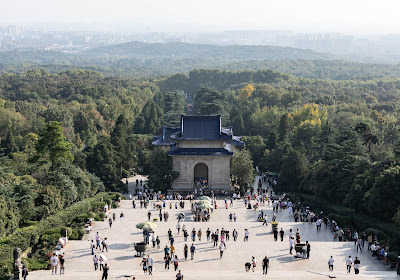Getting off the train in Nanjing felt weirdly familiar - like being back in Hangzhou, after visiting the more rural areas of the past few days.
And yes, Nanjing does have some similarities to Hangzhou, but it's a little less manicured. Still, I liked it, despite a few small difficulties along the way.
I had the late afternoon and evening of my arrival day, so headed to visit the Confucian temple in the Fuzimiao area near my hotel, as well as a museum dedicated to the civil service examination system pioneered by early Chinese emperors and which lasted about a thousand years before they finally ditched it. As night fell the temple and museum and surrounding streets were all lit up and it was very pretty, and also quite nice to be able to continue sightseeing past sunset. I finished the evening at a bar in a new shopping mall which did craft beer and pizza, because I was desperate for something that wasn't rice or noodles.
For the remaining two days I sat down and planned everything based on the Lonely Planet, which promptly let me down at stop number 1. The Nanjing Museum was, it claimed, open until noon on Mondays, so I toddled off there to discover ... it was closed on Mondays. Cue some re-organising of the schedule and rather a lot of walking, to take in some of the sights in the Zhongshan Scenic Area which includes various temples and so on, including the tomb of the first Ming Emperor, Zhu, in a forest on the side of the Purple Mountain that overlooks Nanjing. My mammoth day included walking up to the top of the mountain, catching the cablecar back down, and then walking on towards the Xuanwu Lake and finishing along the city walls. On the way home I had a good dinner at a gimmicky, Qing Dynasty-themed restaurant which is so popular you have to wait for a table. It was tasty and the atmosphere, with music playing, was quite fun. Then a couple of craft beers at the local brewery bar next door.
So I was all set for another good day on day 2. It started with a sobering visit to the Memorial to the Victims of the Massacre of Nanjing, built on one of the many sites where thousands of Nanjingers lost their lives when Japan invaded in 1937. Some 300,000 were murdered and over 20,000 women and girls raped over the first months of the invasion. The museum is thorough, doesn't hold back with images of the slaughter and video testimony from survivors, and was also absolutely rammed. Way too rammed, in fact, for somewhere which is supposed to be thought-provoking, as the first couple of rooms were too busy to appreciate anything properly. It did get better.
Then things went downhill. I went back to the Nanjing Museum, which is free. It has several exhibition halls. I thought perhaps I'd start with the art one. I was directed firmly away from the entrance and towards the history gallery, where I was pointed towards the corner where a lady was taking foreigners' registration. Only you also needed to reserve a slot, but I couldn't do this easily because my WeChat app is blocked and their website is terrible, and in Chinese. Eventually a nice guy from Hong Kong helped me and we emerged triumphant with slips of paper acting as tickets, which were then immediately taken off us again once we'd got through the entry gate. Basically, the museum is free, but you still have to go around it in order and once you're in, you're in.
By this point I wasn't really in the mood for a museum but I wandered around glancing at stuff for a while. There were some interesting items, but I called it a day after a couple of hours, and moved on to the next destination, the Sun Yat-Sen Mausoleum. Sun Yat-Sen is considered as the founder of the Chinese Republic, key to overthrowing the Empire, and they built him a magnificent tomb not too far from the Ming Temple. To get there, I wanted to get the sightseeing bus from the closest metro station. Only ... I needed WeChat again. It took way too much translation app before I could persuade the guy to take my money and let me get on the bus.
The rest of the day improved a bit; the mausoleum was beautiful, and the last stop, Linggu, was quiet and peaceful, so all in all, a good end to the stop in Nanjing.
Practicalities:
- Nanjing is modern and easy to get around, with a good subway system
- there are plenty of malls for easy food options
- the city has two main train stations - Nanjing, and Nanjing South. I arrived into Nanjing South and left from Nanjing, and the Fuzimao area was a decent choice as a place to stay
- as mentioned above, functional WeChat is a great advantage for booking touristy stuff. Passports are required for foreigners for everything I did in Nanjing
- there is a separate entry line for foreigners at the Memorial





No comments:
Post a Comment